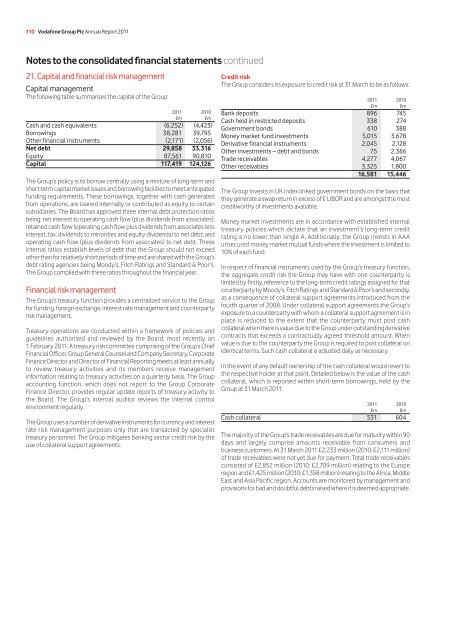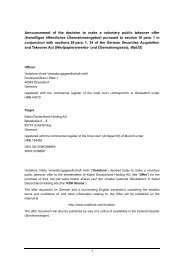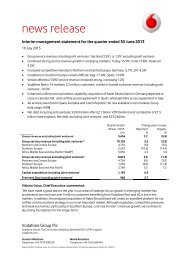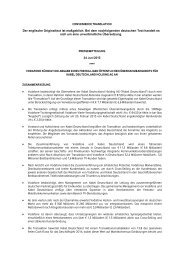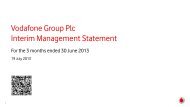Download the report - Vodafone
Download the report - Vodafone
Download the report - Vodafone
You also want an ePaper? Increase the reach of your titles
YUMPU automatically turns print PDFs into web optimized ePapers that Google loves.
110 <strong>Vodafone</strong> Group Plc Annual Report 2011<br />
Notes to <strong>the</strong> consolidated financial statements continued<br />
21. Capital and financial risk management<br />
Capital management<br />
The following table summarises <strong>the</strong> capital of <strong>the</strong> Group:<br />
2011 2010<br />
£m £m<br />
Cash and cash equivalents (6,252) (4,423)<br />
Borrowings 38,281 39,795<br />
O<strong>the</strong>r financial instruments (2,171) (2,056)<br />
Net debt 29,858 33,316<br />
Equity 87,561 90,810<br />
Capital 117,419 124,126<br />
The Group’s policy is to borrow centrally using a mixture of long-term and<br />
short-term capital market issues and borrowing facilities to meet anticipated<br />
funding requirements. These borrowings, toge<strong>the</strong>r with cash generated<br />
from operations, are loaned internally or contributed as equity to certain<br />
subsidiaries. The Board has approved three internal debt protection ratios<br />
being: net interest to operating cash flow (plus dividends from associates);<br />
retained cash flow (operating cash flow plus dividends from associates less<br />
interest, tax, dividends to minorities and equity dividends) to net debt; and<br />
operating cash flow (plus dividends from associates) to net debt. These<br />
internal ratios establish levels of debt that <strong>the</strong> Group should not exceed<br />
o<strong>the</strong>r than for relatively short periods of time and are shared with <strong>the</strong> Group’s<br />
debt rating agencies being Moody’s, Fitch Ratings and Standard & Poor’s.<br />
The Group complied with <strong>the</strong>se ratios throughout <strong>the</strong> financial year.<br />
Financial risk management<br />
The Group’s treasury function provides a centralised service to <strong>the</strong> Group<br />
for funding, foreign exchange, interest rate management and counterparty<br />
risk management.<br />
Treasury operations are conducted within a framework of policies and<br />
guidelines authorised and reviewed by <strong>the</strong> Board, most recently on<br />
1 February 2011. A treasury risk committee comprising of <strong>the</strong> Group’s Chief<br />
Financial Officer, Group General Counsel and Company Secretary, Corporate<br />
Finance Director and Director of Financial Reporting meets at least annually<br />
to review treasury activities and its members receive management<br />
information relating to treasury activities on a quarterly basis. The Group<br />
accounting function, which does not <strong>report</strong> to <strong>the</strong> Group Corporate<br />
Finance Director, provides regular update <strong>report</strong>s of treasury activity to<br />
<strong>the</strong> Board. The Group’s internal auditor reviews <strong>the</strong> internal control<br />
environment regularly.<br />
The Group uses a number of derivative instruments for currency and interest<br />
rate risk management purposes only that are transacted by specialist<br />
treasury personnel. The Group mitigates banking sector credit risk by <strong>the</strong><br />
use of collateral support agreements.<br />
Credit risk<br />
The Group considers its exposure to credit risk at 31 March to be as follows:<br />
2011 2010<br />
£m £m<br />
Bank deposits 896 745<br />
Cash held in restricted deposits 338 274<br />
Government bonds 610 388<br />
Money market fund investments 5,015 3,678<br />
Derivative financial instruments 2,045 2,128<br />
O<strong>the</strong>r investments – debt and bonds 75 2,366<br />
Trade receivables 4,277 4,067<br />
O<strong>the</strong>r receivables 3,325 1,800<br />
16,581 15,446<br />
The Group invests in UK index linked government bonds on <strong>the</strong> basis that<br />
<strong>the</strong>y generate a swap return in excess of £ LIBOR and are amongst <strong>the</strong> most<br />
creditworthy of investments available.<br />
Money market investments are in accordance with established internal<br />
treasury policies which dictate that an investment’s long-term credit<br />
rating is no lower than single A. Additionally, <strong>the</strong> Group invests in AAA<br />
unsecured money market mutual funds where <strong>the</strong> investment is limited to<br />
10% of each fund.<br />
In respect of financial instruments used by <strong>the</strong> Group’s treasury function,<br />
<strong>the</strong> aggregate credit risk <strong>the</strong> Group may have with one counterparty is<br />
limited by firstly, reference to <strong>the</strong> long-term credit ratings assigned for that<br />
counterparty by Moody’s, Fitch Ratings and Standard & Poor’s and secondly,<br />
as a consequence of collateral support agreements introduced from <strong>the</strong><br />
fourth quarter of 2008. Under collateral support agreements <strong>the</strong> Group’s<br />
exposure to a counterparty with whom a collateral support agreement is in<br />
place is reduced to <strong>the</strong> extent that <strong>the</strong> counterparty must post cash<br />
collateral when <strong>the</strong>re is value due to <strong>the</strong> Group under outstanding derivative<br />
contracts that exceeds a contractually agreed threshold amount. When<br />
value is due to <strong>the</strong> counterparty <strong>the</strong> Group is required to post collateral on<br />
identical terms. Such cash collateral is adjusted daily as necessary.<br />
In <strong>the</strong> event of any default ownership of <strong>the</strong> cash collateral would revert to<br />
<strong>the</strong> respective holder at that point. Detailed below is <strong>the</strong> value of <strong>the</strong> cash<br />
collateral, which is <strong>report</strong>ed within short-term borrowings, held by <strong>the</strong><br />
Group at 31 March 2011:<br />
2011 2010<br />
£m £m<br />
Cash collateral 531 604<br />
The majority of <strong>the</strong> Group’s trade receivables are due for maturity within 90<br />
days and largely comprise amounts receivable from consumers and<br />
business customers. At 31 March 2011 £2,233 million (2010: £2,111 million)<br />
of trade receivables were not yet due for payment. Total trade receivables<br />
consisted of £2,852 million (2010: £2,709 million) relating to <strong>the</strong> Europe<br />
region and £1,425 million (2010: £1,358 million) relating to <strong>the</strong> Africa, Middle<br />
East and Asia Pacific region. Accounts are monitored by management and<br />
provisions for bad and doubtful debts raised where it is deemed appropriate.


